It used to be one of the spring break capitals of Mexico. Tens of thousands of college kids from all over Texas would make their way to Brownsville and then across the Rio Grande to Matamoros on the Gulf of Mexico, just a short hop from South Padre Island. The city was lit up with tourist dollars and the sounds of partygoers.
 These days there are only three clubs open in the whole city, residents say, and they are pretty much the private property of drug cartel members.
These days there are only three clubs open in the whole city, residents say, and they are pretty much the private property of drug cartel members.
“We haven’t had a spring break in Matamoros for five years,” said a young woman who asked not to be identified. “We don’t even get the occasional tourist. No one comes here anymore. And anyone who can get out, does.”
For a city of nearly 500,000, Matamoros looks like a ghost town. In the middle of the day during Christmas week, streets were almost deserted. Dozens of stores and office buildings that once provided dental and medical services and goods to gringos are now boarded up. The facades of most buildings haven’t been painted for years, their once-bright reds and blues and greens badly faded.
“Who bothers to paint,” the young woman said, “when you don’t know if you’ll be in business next week or even if you’ll be alive?”
Most people just want to fade into the background, she said — and with good reason. There is a war going on in Matamoros, much as there is across the entire Texas-Mexico border.
The region has always had a frontier mentality, from the days of cowboys robbing stages to Pancho Villa and his men raiding U.S. towns. Its simple vastness and the difficulty of much of the terrain made it the perfect haven for smugglers and people on the run. For many decades, the border lured men looking for prostitution and gambling. During the 1970s, Mexico became the key transit point for marijuana smuggling. Then in the 1980s, along with a wave of illegal immigrants, Colombian cocaine began to come through, bringing with it corruption and violence.
But nothing, even in that blood-spattered history, prepared border dwellers for the wave of violence that has hit the region since Mexican President Felipe de Jesús Calderón Hinojosa decided to send in federal troops and federal police to shut down the drug cartels. In many areas, the cartels are in control to the point that the government, for most intents, has ceased to operate and certainly cannot protect people. The situation has led some observers inside and outside the country to label Mexico as a failed state.
“Our society was defeated,” one Juarez professor said.
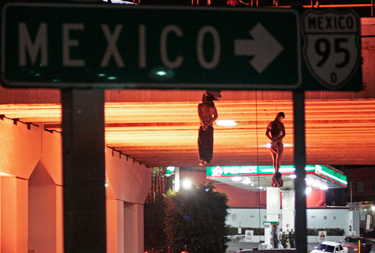 In Matamoros, as in most of the eastern portion of the border region, the war is being fought between two major, murderous drug organizations: the Gulf Cartel and their former enforcers, the U.S.-trained Zetas who splintered off into their own cartel several years ago. Gunfights between the two groups can break out any time of day or night, in any part of the city. And the presence of Mexico’s military and federal police — a strategy implemented by Calderón shortly after his election in 2006 — has exacerbated the situation.
In Matamoros, as in most of the eastern portion of the border region, the war is being fought between two major, murderous drug organizations: the Gulf Cartel and their former enforcers, the U.S.-trained Zetas who splintered off into their own cartel several years ago. Gunfights between the two groups can break out any time of day or night, in any part of the city. And the presence of Mexico’s military and federal police — a strategy implemented by Calderón shortly after his election in 2006 — has exacerbated the situation.
The death toll is breathtaking. In this one city, a string of gunfights among the three groups on Nov. 5 left a reporter, two bystanders, three Mexican Marines, and five Gulf Cartel members — including one of its leaders — dead. And that’s only the minimum casualty estimate: One source on the scene put the number of bodies at 47 or more. Gunfights in early December 2010 left dozens more dead, according to local reports — though figures are hard to pin down, since local news media no longer report on the ongoing conflicts for fear of reprisal. And reports on the casualty count from a gunfight on Dec. 28 are still not in.
“No one can say for certain how many people are being killed in Matamoros these days,” said Luz, a human rights worker born and raised in the city. Like almost every other Mexican resident interviewed for this story, she asked that her full name not be used. “Often, when people are killed, no one even goes to the morgue to pick up the bodies. If you do, you have to answer a lot of questions from the authorities. And many times no one even bothers to pick up dead bodies on the street for days: If you do, and if the dead person was part of a cartel, the group who killed that person might think you are also part of the cartel and kill you as well.
“And don’t forget the number of people who disappear,” she said. “Hundreds. Thousands. I dare you to find a single family in Matamoros that has not had a family member kidnapped.”
Versions of this horror story are being played out in other border towns all the way to El Paso. In places like Ciudad Mier, a small town just a short drive from Matamoros, most of the residents have fled the violence, either trying to make it to the U.S. or hoping they can disappear in larger Mexican cities until their own city quiets down.
The unprecedented violence has virtually shut down portions of the border, devastating local economies, families, and a border culture that has always flowed relatively freely between two countries.
The U.S. Border Patrol would not provide data about how many cars cross the international bridges in Matamoros these days as opposed to the past, but agents encourage U.S. citizens to turn back. “It’s just not safe, even during the day,” one agent told a reporter on a recent trip.
“I can’t give you figures, but I can tell you that this war has ripped cross-border traffic apart,” said Anthony Zavaleta, an anthropologist who teaches at the University of Texas at Brownsville. He and his wife have family on both sides of the border, and going across used to be like going across town, he said. “Now you have to plan your trip. You need three hours just for the crossing because of tightened security — and more if you’re walking. And you need enough time to get back before dark because that increases your chance of running into violence. And you call before you go to see if it is calm or not. But it’s never completely calm. We get reports of a firefight going on in Matamoros almost every day.
“What used to be a fun, sort of wild place, is now lawless.”
At the crossing into Reynosa, just an hour up U.S. Highway 281 from Matamoros, a border patrol agent says things have been quiet for a couple of days, but clearly he doesn’t think it’s safe to cross over.
“If you have to go, do, but finish whatever you’re doing and come back as quickly as you can,” he said.
Reynosa, across the border and a couple of miles from McAllen, has been living with the same violence as Matamoros for the last year or two. The evidence is everywhere: Guarding the bridge on the Mexican side is a Mexican Marine in full battle gear and armed with an automatic weapon. His post is behind a three-sided wall of sandbags.
The streets are not quite as desolate as those in Matamoros, but there are still boarded-up buildings, and stores on the plaza are protected by steel bars or gates. There are simply no American tourists here, local residents said.
Signs in an open-air parking lot reflect how violent things can get. The chilling message, in Spanish, warns: “We are not responsible for damage, theft,
or firebombing.”
The woman behind the counter of a small grocery store said she and her neighbors have just learned how to live with
the fear.
“When there is a truce or when the cartels move to another city to fight, it’s calm,” she said. “When they fight here, we just pray.”
Do the cartels demand payment for protection from the store? “I can’t talk now,” she said, and looked down at the ground.
Like Matamoros, Reynosa traditionally was a Gulf Cartel stronghold, but now the Zetas are fighting to wrest control of it for themselves. The most vicious fighting occurred in the spring of 2010, but sporadic fighting continues, with gun battles occurring with some regularity between the two cartels and also between the cartels and the Mexican military.
Surprisingly, a casino is open not far from the international border: The security guard nods when asked if it’s the property of the cartels. A street hustler warns against entering if you have no business there.
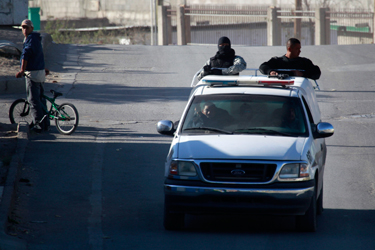 All but one of the dozen bars around the plaza are boarded up. Dutch’s, the single one open for business is dark inside, and three Mexican college kids at the bar are the only customers at 4 p.m. Thousands of U.S. dollar bills are taped to the back of the bar, on walls, and on ceiling rafters, each heavily defaced with black markers, many with the names of the people who left them as part of the collection.
All but one of the dozen bars around the plaza are boarded up. Dutch’s, the single one open for business is dark inside, and three Mexican college kids at the bar are the only customers at 4 p.m. Thousands of U.S. dollar bills are taped to the back of the bar, on walls, and on ceiling rafters, each heavily defaced with black markers, many with the names of the people who left them as part of the collection.
Dutch’s is an institution in Reynosa — open since 1947 and a hopping spot until about five years ago, the bartender, Armando, said. That’s when the military came to Reynosa to stop the cartels. U.S. business dropped to nothing overnight, and Mexican business dropped at the same time, he said. “We weren’t afraid of the cartels before. They were here, but they just did their business. When the military came everything spilled out onto the streets. It just got very bad.”
Now Dutch’s is barely getting by. Friday and Saturday nights are sometimes busy with local customers only, Armando said, and even then, “we close early because people don’t stay out late.”
Armando said that there’s been no violence at Dutch’s in the 10 years he has worked there, an indication that the place may be under the protection of one of the cartels, though he would not confirm that.
“We just are happy that we have business and that this [bar] is a peaceful place,” he said. He wishes the gringos would come back, but he understands why they’re afraid.
The strategy Calderón is using against the cartels is the same one used successfully in the early 1990s by Colombian forces to defeat the Medellin and Cali cartels — and also used, by police and other non-military agencies, to break up the New York mafia families. It’s called “atomization,” and the idea is to go after the cartel leaders: If you can take them out, the cartels will split up, and the resulting smaller groups will theoretically be weaker, both financially and politically. The drawback is that the strategy creates power vacuums that can lead to violence, as various lower-echelon cartel leaders fight for the top spot. The violence that was once contained within the cartels spills out into the streets.
“That’s what has ruined Mexico,” said a U.S. border journalist who grew up in Mexico and asked that neither his name nor affiliation be mentioned. “We had cartels doing their business, and their business was supplying drugs to the United States. Yes, it caused corruption, but regular people didn’t really see it. And a lot of regular people earned good money being part of the chain that moved those drugs. So people went about their business without fear of the cartels.”
But serious trouble started in 2003, when Gulf Cartel leader Osiel Cardenas Guillen was arrested and sent to a maximum-security Mexican prison. Though he continued to lead the cartel from his cell with the help of his brothers, his hold on his hired gunmen, the Zetas, was weakened.
“Osiel Cardenas had the Zetas under his thumb. But with him gone, they began to grow into their own cartel. That’s when things went wrong,” the journalist said. “If he was still around, there would not be a Zetas. They went from being an armed force for the Gulf cartel to being a thug force.”
The difference is that the Zetas don’t just fight law enforcement and other drug groups. Without control of lucrative cocaine routes, they “diversified” into all kinds of crimes against the populace at large — extortion, kidnapping, robbery. “They had no rules,” the reporter said. “They didn’t avoid women and children. They will exploit a shoe shop for a few dollars. So things went from being closed cartels doing private business to overall crime. And things began to go out of control.”
By the time Calderón took office, there seemed little choice left other than to go after the cartels with the military. “You have to blame the Zetas for changing the way things were done,” said the journalist. “But bringing in the military and trying to splinter all of the cartels” made it worse.
Now, he said, “the Zetas are everywhere. They are fighting with the Juarez cartel against the Sinaloa cartel. And the Juarez cartel is strong enough to keep them in line, at least for now. But if they [the Juarez cartel] weaken, if they lose another leader or two, the Zetas will turn on them. They want to control everything.”
The Zetas, who started out as a group of elite Mexican military special forces trained by the U.S. military to fight the war on drugs, are recruiting kids out of high school — and many of those kids don’t see what other choice they have.
The group is very public with its violence. In August, the Zetas killed 72 migrants en route to Matamoros — supposedly for simply not paying them a tithe to cross territory they claim as their own. That same month, in Piedras Negras, across the border from Eagle Pass, the bodies of two men were found with a message written on cards on their bodies, warning people not to associate with other cartels or they would meet the same fate. On top of one of the bodies, which showed signs of having been brutally beaten and tortured before death, the bodies of the dead man’s cat and dog had been placed. A similar scene occurred earlier in the year in Nuevo Laredo.
Nuevo Laredo, just across the river from Laredo, seemed almost cheerful on a recent visit, compared to Reynosa and Matamoros. Even the U.S. Border Patrol agent at the crossing seemed upbeat. “Have a good time,” he said with a smile.
Instantly apparent were freshly painted stores and houses. Tourist police, albeit well armed, were in evidence rather than the military. Shoppers, though none from the U.S., were on the streets and in the bustling shops. The violence of several years ago, when the Gulf Cartel and then the Zetas battled the Beltran-Levya cartel for control of I-35, had sprung up again early last year but by fall had subsided considerably. One huge mall a couple of miles from the international crossing was anchored by a gleaming H.E.B. grocery store, and several other U.S. stores were also open there. Shoppers seemed generally cheerful, without the haunted, worried look of people on the street in some of the other border cities.
Some neighborhoods are still scary, a street sweeper said, but added, “We are forgetting our constant fear.”
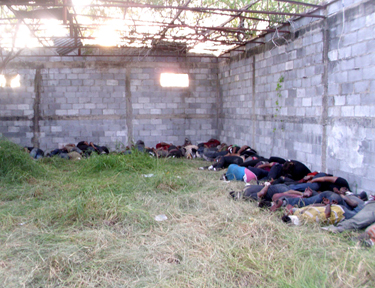 A woman who lives in Laredo but spends two days a week on the Mexican side said the calm and prosperity are partly a facade. “Having lived here all my life, what I see is how many shops and stores are closed,” she said. “An outsider wouldn’t notice it as much as we do, because you still see people selling food on the street and kids going to school and in the parks. But it’s different. Some people have moved away to get away from the violence. Tourists won’t come.
A woman who lives in Laredo but spends two days a week on the Mexican side said the calm and prosperity are partly a facade. “Having lived here all my life, what I see is how many shops and stores are closed,” she said. “An outsider wouldn’t notice it as much as we do, because you still see people selling food on the street and kids going to school and in the parks. But it’s different. Some people have moved away to get away from the violence. Tourists won’t come.
“It’s not as bad as rumors make it out to be, but it’s not good either,” she said. “It’s not the city I was born in.”
Ralph Watterson, who owns the Old Home Supply House in Fort Worth, has been making buying trips to the Laredo area for years. On both sides of the border, he said, the economy is being affected by the violence.
“Ever since the drug violence increased, people have stopped going to Laredo,” he said. He talked about the SUVs full of shoppers from cities like Houston and San Antonio that in past years would load up, drive to Laredo, and spend the night or the weekend shopping, dining, and going to clubs on both sides of the border. “That’s not happening anymore,” he said. “No one is going over there.”
He said he still feels safe in the parts of Nuevo Laredo closest to the international bridges but that anyone who ventures away from those areas “is probably taking their lives in their hands.”
On his most recent trip, he said, he made “a lot of mercy purchases” — buying more than he normally would have, from people whose businesses are not doing well.“The people I deal with at the border are the nicest people in the world,” he said. “It’s sad that these people are caught in the crossfire.”
The young Laredo woman said the relative peacefulness of her city is due to the fact that “the Zetas have control of most of it,” she said. “I go to the stores with my parents, and we go out to dinner. But we don’t go out at night. Nobody goes out at night. And if you own a late-model truck or car, you don’t bring it here.
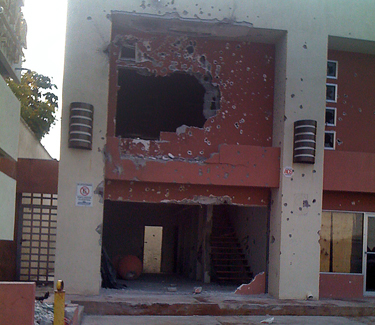 “People still jump when they hear different sounds. And if you are driving, and you see four or five trucks driving fast, you just get out of their way,” she said. “Even the police get out of their way. The narcos can do anything.”
“People still jump when they hear different sounds. And if you are driving, and you see four or five trucks driving fast, you just get out of their way,” she said. “Even the police get out of their way. The narcos can do anything.”
She’s right to be jumpy: Two days after Christmas, at least five people were killed in a shootout. Outsiders don’t go into Boys’ Town for the drinking and the girls anymore. That belongs to the cartel now, she said.
And things might be getting ready to get worse: On Dec. 20, as many as 300 men were allowed to walk out of the state prison in Nuevo Laredo — guards simply opened the doors for them. Earlier in the year, as many as 200 other prisoners were allowed to walk free from other prisons in Reynosa and Matamoros.
Thus far no one is answering the question of whether the Nuevo Laredo guards were paid or coerced with threats of violence. Some locals said most of those released were Zetas, giving the group a huge number of additional gunmen to help fight their wars.
The Zetas engineered those releases because they badly needed the manpower, said a spokesman for Grupo Savant, a U.S.-Mexico policy think tank founded by former members of the Drug Enforcement Administration’s intelligence division.
“They’re fighting the Gulf Cartel in so many places, and so many of them have been arrested or killed that they are thin in manpower at some points,” said the spokesman, who asked that his name not be used. All the border territory east of Big Bend is in contention, he said, including the five border-crossing cities — Piedras Negras, Nuevo Laredo, Acuña, Reynosa, and Matamoros.
“A couple of those have been quiet for a couple of months, but they’re still contested and will flare up again,” he said.
To realize the potential power of the Zetas, one only has to look at Piedras Negras. On a recent visit, the city seemed vibrant, with construction crews everywhere and an impressive, newly rebuilt international bridge complete with a huge metal and glass sculpture of flying birds. Fresh paint glistened, and Christmas shoppers carried overstuffed bags apparently without a worry in the world. There wasn’t a shred of Mexican military presence.
And yet for months during 2009 and into 2010, gunfights were a regular part of the city’s daily life. Quiet came only when the Zetas took full control — or as the Grupo Savant spokesman said, “For now it’s a Zeta stronghold and the least contested of the five cities. For now.”
Locals went further: They said the Zetas also made a deal with the Mexican government for peace in exchange for being allowed to go about their business unimpeded.
How unimpeded? Some of the men working on the plaza reconstruction were finishing putting up a copper flagpole that must have been 40 feet tall.
“This pole,” one of them said, “will never fly the Mexican flag.” The plaza belongs to the Zetas, not Mexico.
On the other side of Texas sits Juarez, the most violent city in Mexico and one of the most violent in the world. The reigning Juarez Cartel uses the Zetas as hired guns in a war with the Sinaloa Cartel, which is challenging them for control of the city and the entire state of Chihuahua. And both cartels are simultaneously and very actively at war with the Mexican army and federal police. The fight is so bitter and protracted that the people there are losing faith in everything — including the rule of law and their own government.
The streets of this city of 1.3 million are dead by 9 p.m. Restaurants and shops are boarded up, and for-sale signs are everywhere. Those who can leave, have. Even simple things like stoplights and traffic signs have lost their meaning in a world where motorists are afraid to stay still long enough for a light to change because of the very real prospect of gunfire or carjackings. Drivers lock their doors and keep an eye out for suspicious motorists. Women rarely drive alone.
“When you leave a place,” said a small business owner, “you look around at your surroundings” before entering your car. “You look in the rearview mirror at all times. You don’t put the music on. You can’t afford to be distracted in Juarez.”
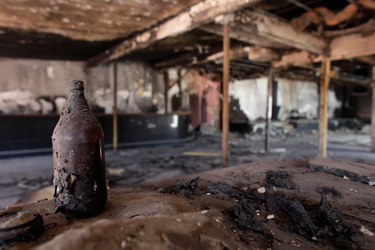 The fighting here has produced many of the most wretched images of the border war: decapitated bodies hung from highway overpasses, people nailed to their front doors, headless bodies stacked along roadsides. The difference between Juarez and the other border cities is that there has been no occasional abatement, no periods of calm. It has been relentless, and no group has escaped the carnage.
The fighting here has produced many of the most wretched images of the border war: decapitated bodies hung from highway overpasses, people nailed to their front doors, headless bodies stacked along roadsides. The difference between Juarez and the other border cities is that there has been no occasional abatement, no periods of calm. It has been relentless, and no group has escaped the carnage.
Even doctors are vulnerable, even teachers. The kidnapping and killing of an orthopedic surgeon in December triggered a 24-hour strike by doctors demanding more protection from the government. That same month, the drug thugs publicly threatened to shoot up several Juarez schools unless teachers handed over their end-of-the-year bonuses.
News outlets have stopped carrying drug stories because several reporters and photographers have been killed doing just that. Even El Diario de Juarez, the paper of record in the city, stopped covering cartel activity after two photographers were shot, one fatally, in mid-September. The paper had lost another reporter to drug violence two years earlier.
In a now-infamous Sept. 19 front-page editorial addressing the cartels, the paper’s editors pleaded: “Leaders of the different organizations that are fighting for control of Ciudad Juarez: The loss of two reporters from this publishing house in less than two years represents an irreparable breakdown for all of us who work here, and, in particular, for their families. We ask you to explain what you want from us, what we should try to publish or not publish, so we know what to expect.”
Those reporters and photographers who continue to cover the violence do it in groups, arrive after the violence has ended, and then, in their stories, avoid placing blame on one group or another in an effort to keep from attracting the wrath of the cartels — or corrupt military or police.
One photographer for El Diario described his realization of how pervasive that violence had become. He was taking pictures of a protest when he accidentally captured the image of a drug dealer at a bus stop. The dealer took out his gun, pointed it at the photographer, and demanded the camera. The photographer asked him if he would settle for the memory card. He did.
“That was the moment it hit me,” he said.
Even worse is the Valley of Juarez just to the southeast. Locals call the string of border communities there the Valley of Death. Here the people are totally defenseless from the cartels, and in some places 90 percent of the population has fled. On Dec. 24, the police chief of the tiny town of Guadalupe was kidnapped. Erica Gandara had joined the Guadalupe force in June 2009 as a dispatcher. That same week an officer was killed. The seven other officers resigned within a year, leaving Gandara as the town’s sole officer.
Gandara is not the only female police chief to face cartel violence in the state of Chihuahua. On Nov. 29, Hermila Garcia, police chief of a little place called Meoqui, about 300 miles south of Juarez, was gunned down on her way to work. She had been at her job just seven weeks.
The kidnapping of Gandara followed a long string of vicious acts in Guadalupe. On June 19, Guadalupe’s mayor was shot and killed in front of his wife and children. Just a week before Gandara disappeared, the town’s alderman saw his house burned to the ground. Hundreds of homes and businesses have also been torched. People hide in their homes after 5 p.m.
One woman, Mari, who still lives in the violence-wracked town, has already seen her husband killed and her sister “disappeared.”
“We are living at God’s mercy,” she said.
It’s not only the cartels that are killing people. On the gang-ruled western outskirts of Juarez, locals fear the federales as much as the cartels. One resident said the federal police regularly commit crimes against the people. Residents try not to leave their homes unless absolutely necessary just to avoid confronting them.
They still brave the dangers on Sundays to gather at the Church of San Estaban. The church sits on a hill that overlooks both modern El Paso in the U.S. as well as one of the poorest areas of Juarez.
One woman there, Yoly, said her husband was kidnapped in January 2009, and there is still no word on whether he is alive.
Thus far, only one community has fought back against the violence. Ascension, a city of about 10,000 that sits 120 miles southwest of Juarez, got so fed up with kidnappings that in September a mob killed two 17-year-old boys accused of abducting a teenage girl.
Ignacio Rodríguez, a custom cabinet-maker and now deputy mayor of Ascensión, watched it happen. As the crowd of hundreds beat the boys to death, he realized that they all had daughters, aunts, or wives who had been victims of kidnappings. The rage had been accumulating for a year, during which the city averaged three kidnappings a week.
“We could not continue living a life that is like hell,” Rodríguez said the day after the deaths.
Now, the remote town and its surrounding fields of cotton and red chiles have a postcard quality. Children play in the plaza. Police have installed a siren to alert all residents when a kidnapping occurs, and cameras cover the entry points to the town. Vigilantes have dug a moat to prevent kidnappers from fleeing after attacks. Men hang out in the center of the town, and shoe shiners work at their booths. No gangs have attacked the town of Ascensión since that day.
In some ways, the people of Juarez seem resigned to the violence around them. At a free outdoor skating rink, food vendors sell hot dogs and pastries, and federal police maintain a heavy presence. Not far away, an Applebee’s restaurant books rock bands regularly, and young people drink beer at bars and restaurants near the U.S. consulate — though three people connected with the consulate have been killed in the past year, and the consulate itself was temporarily closed in late July due to cartel bomb threats.
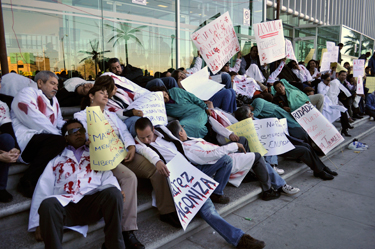 Juán González, director of a nonprofit organization that offers psychotherapy for low-income families, said that the people in Juarez are suffering from a collective psychosis.
Juán González, director of a nonprofit organization that offers psychotherapy for low-income families, said that the people in Juarez are suffering from a collective psychosis.
“What has happened [in Juarez] is very similar to what happens in war zones. We make decisions based on the violence. We don’t go to restaurants where we hear executions have happened,” he said. “It’s very common for people to talk about the violence, because there are very few people who have not been affected by it.”
In schools, children are taught how to react in the event of a shootout.
One professor at the Autonomous University of Ciudad Juárez said he has little hope that peace will find his city any time soon.
“Our government has been defeated,” he said. “Our society was defeated.”
On street corners around Matamoros, Mexican military personnel in full combat gear — plus ski masks to hide their identities — stand in the back of pickup trucks, Humvees, and Bradley fighting vehicles, holding automatic weapons. Many of the vehicles are outfitted with .50 caliber machine guns. The Best Western Plaza Hotel not far from an international bridge sported 10 federal police vehicles in its parking lot, guarded by a federal police officer armed with a sniper rifle. Another federale, similarly dressed and carrying an automatic rifle, stood at the entrance to the parking lot. Two more protected the front and side doors of the hotel.
In the coffee shop, where she and a reporter were the only customers, Luz talked about life in Matamoros. “People are trying to lead normal lives. But they are just pretending,” the human rights worker said. “Or their idea of normal has changed so much that they think it is normal that they don’t go out at night. That it’s normal to have theaters but no shows or that you never see children in the street.”
In a nearby (and nearly empty) boutique, a saleswoman talked about waiting out the bullets. “If you hear shooting, you just run into a store and hide. You just wait until it’s over. What else can you do?”
Experts estimate that 28,000 to 36,000 people have died in drug-related violence in Mexico since the inception of Calderon’s military offensive against the cartels in 2006. The final tally for 2010 alone is expected to hit nearly 13,000.
The border journalist said that the real numbers are probably much higher. “You have to understand first that there is a complete news blackout in Mexico,” he said. “When the cartel says you can report something, you can. Without permission, you are killed. So Mexican reporters pass their information across the border to U.S. outlets.”
When a firefight occurs, each cartel tries to carry off its dead, as does the military — to prevent the opposition from knowing how many of their enemies died. “You have blood on the street but no bodies. So the number of dead is much higher than what is actually reported,” the journalist said. “I was at one site last year where there were 10 bodies in one place and 12 in another. In a little while there was only one, an innocent bystander. So that’s what the police reported: One dead, when there were 22.
“Those bodies that are not counted are called the ‘invisible dead,’ ” he said. “In Matamoros alone I can count several thousand killed over the last five years. Whatever you hear or read, it’s much worse than that.”
Calderón praises his military offensive as being responsible for the capture or death of top members of every cartel in Mexico. But many people say that offensive is also responsible for the the violence that is tearing the border apart. Luz is one of them.
“Before the government sent the military here five years ago, the cartels were killing each other, but they had respect for women and children,” she said. “But the military kill everyone, including women and children, when a firefight breaks out. And they don’t apologize later.”
She’s not alone in her anger. Signs stuck on light poles and building facades call for the Marines to leave the city. Others say, in Spanish, “Military Forbidden — Only Humans Here.”
“I’m a human rights worker, but we have no human rights here,” Luz said. “We have no social services. Nothing. I used to fight with the government over human rights issues, but I can’t anymore. And neither can the other human rights workers because the government is doing as much of the abusing as anyone else.”
Why doesn’t she leave?
“This is my city. I was born here,” she said. “I will stay and do my best to defend it and its people. I will have nothing if they can make me run away.”
El Paso journalist Adriana Gómez Licón contributed to this story.












Seems that alot of drug deals are made in our border towns on our side. cartel has contracted money hungry runners to get drugs across the river that is convient for americans looking for cheap (blood) drugs, where they will transport it back to our urban neighborhoods and sell it for ten times the amount they paid for it. “Not bad for two days drive”. If our “D.E.A. AGENTS” would double up for 6 months and really penertrait on our border towns and check every thing going out and have cameras catching license plates that goes into T.D.P.S. DATA BASE could thin THE BLOOD DRUGS traffic to where the cartels could get weaker. The more drugs that are purchased by our so called american drug buyers from our TEXAS border towns will populate more groth of viloence and insure cartel strength . Your story and your information is really sad to digest of what happens there. No wonder we have a border problem. If it was you or i born and raised there with the scars of murder and war within our own nationality and country to see your or my parents-grandparents living in that enviorement, we no doubt would be in the UNITED STATES, no wonder mexicans will work so cheap cause its better than being DEAD. Drug dealers in states useaily have other ways for means of income'{because it takes capital that drug users dont have} dealers here in the states should employee mexicans working for their legal sorce of income that way their consonious wont bother them as much .